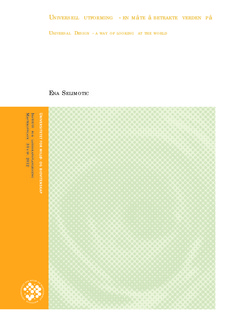| dc.description.abstract | Universell utforming er en planleggingsstrategi som går ut på å gjøre omgivelser og produkter tilgjengelige for alle. Universell utforming har blitt veldig viktig på kort tid. Begrepet kommer fra USA og det ble først tatt opp av arkitekten Michael Bednar. Begrepet universell utforming baseres på et etisk prinsipp om at ingen mennesker skal diskrimineres. Dette fagfeltet har over tid blitt viktig for ulike organisasjoner slik som FN, ulike land og myndigheter. Alle disse skaper sine egne perspektiver på fagfeltet. Universell utforming handler om deltakelse i samfunnet. Det handler også om å skape et samfunn for alle mennesker. Det er ikke gjort mye forskning på barn i forhold til universell utforming. Hvilket perspektiv har de på fagfeltet? Jeg har observert skolebarn, mens de har gått ulike skoleveier. Dette er et eksempel på hvordan disse barna deltar i
samfunnet, på en måte. Barna deltar i sitt lokalsamfunn, gjennom ferdselen
til og fra skolen, ved å være sosiale. Elevene er opptatte av å leke med hverandre, ta snarveier, og snakke sammen. Barna bruker et større område enn kun en veistrekning gjennom sin ferdsel til og fra skolen. Universell
utforming er derfor ikke kun interessant i forhold til skoleveien. De aktuelle strekningene er eid og forvaltet av et sett av myndigheter. Intervju med representanter fra disse myndighetene har bidratt til å danne et bilde av deres perspektiver på universell utforming. Regjeringen har en visjon om at Norge skal være universelt utformet innen 2025. Denne visjonen krever samarbeid mellom mange ulike myndigheter og betyr en samling av mange perspektiver på universell utforming. Hva kreves for å nå en så ambisiøs visjon? Universal design is a strategy for making environments and products accessible and usable to everyone. The term universal design originates from the United States. It was first mentioned by the architect Michael Bednar. Universal design has an ethical principle: nobody should be discriminated
against. Universal design has over time become important to various organisations such as the
United Nations, other countries and other authorities. They all create their own perspectives on universal design.
Universal Design has to do with participation in community. The idea is to create a community for all people. There is not a lot of research done about children and universal design. What perspective do children have to universal design? I have done a study on schoolchildren and their road to school. This study show how these children participate in their local community. They participate in the local
community by being social with each other. I have observed the children during their walk to school and back. These observations have shown that they love to play, take shortcuts and talk to each other. The children use a wider area than just the road to school. Universal design, in this case, is therefore not only important for the school road but also for a much larger area. The school roads are owned and managed by a set of authorities. Interviews with representatives from these authorities have contributed to creating a picture of what perspectives these authorities have to universal design. The government has a vision that Norway is to be universally designed by
the year 2025. This vision requires cooperation between many authorities and a collection of
different perspectives on universal design. What does it take to achieve such an ambitious vision? | no_NO |
